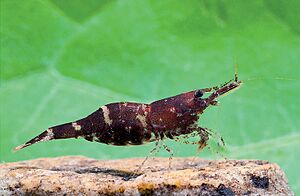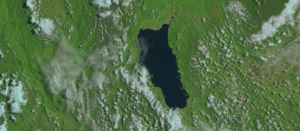Caridina sarasinorum facts for kids
Quick facts for kids Caridina sarasinorum |
|
|---|---|
 |
|
| Conservation status | |
| Scientific classification | |
 |
|
| Lake Poso, Sulawesi, Indonesia |
The Caridina sarasinorum is a special type of freshwater shrimp. It's a small creature that belongs to the Atyidae family. This shrimp is unique because it's found only in one place: Lake Poso on the island of Sulawesi in Indonesia. In fact, it's one of eight different Caridina shrimp species that live only in this lake.
About This Shrimp
What it Looks Like
Caridina sarasinorum has eyes that are quite big for its size. They reach about 80% of the length of its first antenna segment. Its long antennae help it feel around and learn about its surroundings.
The shrimp also has a special part called a rostrum, which is like a small horn on its head. It curves upwards and has tiny teeth on both its top and bottom. These features help the shrimp explore and find food.
Where it Lives
This shrimp lives only in Lake Poso, which is a large lake in Sulawesi, Indonesia. The lake covers about 323 square kilometers, and the shrimp can be found all over it.
Caridina sarasinorum is not picky about where it lives in the lake. You can find it on rocky shores, on sand, on wood, and even on aquatic plants. The water in Lake Poso is freshwater and a bit alkaline, with a pH usually between 9 and 10. The water temperature is warm, ranging from 24°C to 29°C (75°F to 84°F).
Shrimp Babies
Female Caridina sarasinorum carry their eggs under their bodies. The eggs are quite small, measuring about 0.85 mm by 0.5 mm. This is how these special shrimp continue to live and grow in Lake Poso.


